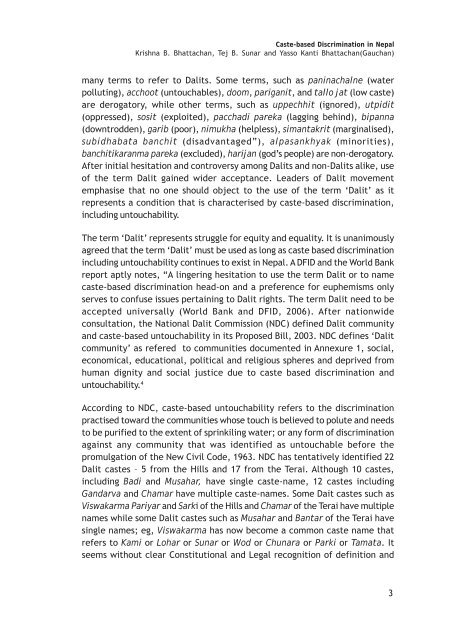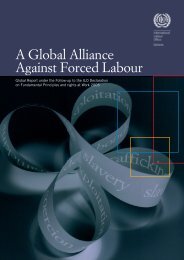Caste-based discrimination in Nepal - International Dalit Solidarity ...
Caste-based discrimination in Nepal - International Dalit Solidarity ...
Caste-based discrimination in Nepal - International Dalit Solidarity ...
You also want an ePaper? Increase the reach of your titles
YUMPU automatically turns print PDFs into web optimized ePapers that Google loves.
<strong>Caste</strong>-<strong>based</strong> Discrim<strong>in</strong>ation <strong>in</strong> <strong>Nepal</strong><br />
Krishna B. Bhattachan, Tej B. Sunar and Yasso Kanti Bhattachan(Gauchan)<br />
many terms to refer to <strong>Dalit</strong>s. Some terms, such as pan<strong>in</strong>achalne (water<br />
pollut<strong>in</strong>g), acchoot (untouchables), doom, pariganit, and tallo jat (low caste)<br />
are derogatory, while other terms, such as uppechhit (ignored), utpidit<br />
(oppressed), sosit (exploited), pacchadi pareka (lagg<strong>in</strong>g beh<strong>in</strong>d), bipanna<br />
(downtrodden), garib (poor), nimukha (helpless), simantakrit (marg<strong>in</strong>alised),<br />
subidhabata banchit (disadvantaged”), alpasankhyak (m<strong>in</strong>orities),<br />
banchitikaranma pareka (excluded), harijan (god’s people) are non-derogatory.<br />
After <strong>in</strong>itial hesitation and controversy among <strong>Dalit</strong>s and non-<strong>Dalit</strong>s alike, use<br />
of the term <strong>Dalit</strong> ga<strong>in</strong>ed wider acceptance. Leaders of <strong>Dalit</strong> movement<br />
emphasise that no one should object to the use of the term ‘<strong>Dalit</strong>’ as it<br />
represents a condition that is characterised by caste-<strong>based</strong> <strong>discrim<strong>in</strong>ation</strong>,<br />
<strong>in</strong>clud<strong>in</strong>g untouchability.<br />
The term ‘<strong>Dalit</strong>’ represents struggle for equity and equality. It is unanimously<br />
agreed that the term ‘<strong>Dalit</strong>’ must be used as long as caste <strong>based</strong> <strong>discrim<strong>in</strong>ation</strong><br />
<strong>in</strong>clud<strong>in</strong>g untouchability cont<strong>in</strong>ues to exist <strong>in</strong> <strong>Nepal</strong>. A DFID and the World Bank<br />
report aptly notes, “A l<strong>in</strong>ger<strong>in</strong>g hesitation to use the term <strong>Dalit</strong> or to name<br />
caste-<strong>based</strong> <strong>discrim<strong>in</strong>ation</strong> head-on and a preference for euphemisms only<br />
serves to confuse issues perta<strong>in</strong><strong>in</strong>g to <strong>Dalit</strong> rights. The term <strong>Dalit</strong> need to be<br />
accepted universally (World Bank and DFID, 2006). After nationwide<br />
consultation, the National <strong>Dalit</strong> Commission (NDC) def<strong>in</strong>ed <strong>Dalit</strong> community<br />
and caste-<strong>based</strong> untouchability <strong>in</strong> its Proposed Bill, 2003. NDC def<strong>in</strong>es ‘<strong>Dalit</strong><br />
community’ as refered to communities documented <strong>in</strong> Annexure 1, social,<br />
economical, educational, political and religious spheres and deprived from<br />
human dignity and social justice due to caste <strong>based</strong> <strong>discrim<strong>in</strong>ation</strong> and<br />
untouchability. 4<br />
Accord<strong>in</strong>g to NDC, caste-<strong>based</strong> untouchability refers to the <strong>discrim<strong>in</strong>ation</strong><br />
practised toward the communities whose touch is believed to polute and needs<br />
to be purified to the extent of spr<strong>in</strong>kil<strong>in</strong>g water; or any form of <strong>discrim<strong>in</strong>ation</strong><br />
aga<strong>in</strong>st any community that was identified as untouchable before the<br />
promulgation of the New Civil Code, 1963. NDC has tentatively identified 22<br />
<strong>Dalit</strong> castes – 5 from the Hills and 17 from the Terai. Although 10 castes,<br />
<strong>in</strong>clud<strong>in</strong>g Badi and Musahar, have s<strong>in</strong>gle caste-name, 12 castes <strong>in</strong>clud<strong>in</strong>g<br />
Gandarva and Chamar have multiple caste-names. Some Dait castes such as<br />
Viswakarma Pariyar and Sarki of the Hills and Chamar of the Terai have multiple<br />
names while some <strong>Dalit</strong> castes such as Musahar and Bantar of the Terai have<br />
s<strong>in</strong>gle names; eg, Viswakarma has now become a common caste name that<br />
refers to Kami or Lohar or Sunar or Wod or Chunara or Parki or Tamata. It<br />
seems without clear Constitutional and Legal recognition of def<strong>in</strong>ition and<br />
3

















